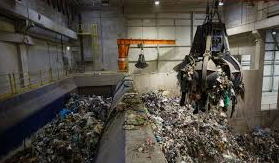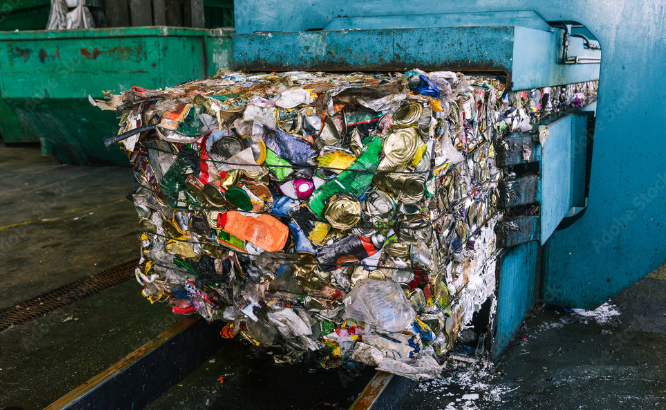Sorting of recoverable residues from household waste
The requirements for waste sorting, particularly of household waste, have grown significantly. The current discourse is concerned with the protection and conservation of resources with the recovery of recoverable materials and raw materials from waste. For companies, economic considerations have become increasingly important, along with maintaining competitiveness. Accordingly, the trend is continuing towards ever higher material recycling rates, which are best obtained by automated sorting.

Apart from ferrous and non-ferrous metals, plastics in particular are sorted out from household waste, so that they can provide higher-quality material to the recycling process and thus complete the cycle. This primarily affects classic plastics such as PE, PP, PET and PS – dimensionally stable materials – but can also be valuable in the form of film.

In a modern sorting plant, household waste is first pre-treated (pre-crushing ,bag opening, sieving, manual sorting, ballistics separation) and then processed using magnet and eddy current separation for metal recovery, then plastic separation using technology here materials are recovered.
ZHONGCHENG offers you high-performance, application-specific magnet technology, for example in the form of overhead suspension magnets, drum magnets, or non-ferrous metal separators.
Our inductiondetect stainless steel and all residual metals to sort these following the magnetic separation stage. Organic materials such as wood, paper/cardboard/paperboard and all types of plastics are sorted usin near-infrared-sorting series systems. In many installations hyperspectral imaging technology is replacing labour-intensive manual picking to sort the items by material type.
Additionally, you can extendfunctionality with various sensors of different types, thus making even complex sorting tasks realistic in a single work step, with colour recognition and metal detection.
In modern systems, one particular challenge is the sorting of flat objects that are prone to flying, such as film and paper, because they move around on the sorting belt and so cannot be accurately sorted after detection. We address this challenge with the . Here an airflow is created in the same direction of movement as the sorting belt (AOC = active object control), to stabilize this flat material on the accelerator belt and so hold it in place during sorting. At the same time the offers high sorting belt speeds of up to 4.5 m/s and thus achieves remarkable throughput rates.
Black and dark-coloured objects are normally not detected by conventional systems. The result is that they pass undetected through the sorting process, are not fed into the recycling circuit and so do not contribute to achieving the sorting rates. offers a solution here: By sorting black and dark-coloured valuable residues from the waste material stream, it delivers a significant contribution to resource conservation and protection while providing the operator with an additional economic benefit.
- All core combinations of magnet and sensor-based sorting systems from a single source
- Sorting widths from 0.5 m to 2.8 m available
- Fe and non-Fe metals, recovery with magnet and eddy-current technology
- technology; sorting of recyclable materials using sensors
- technology for sorting lightweight materials and film
- Special functions for detecting dark plastics and materials
-
 Trommel screenTrommel screen, also known as drum screens, are widely used in various industries for sorting and separating materials.Get Quote
Trommel screenTrommel screen, also known as drum screens, are widely used in various industries for sorting and separating materials.Get Quote -
 Crop straw double shaft shreddApplications:Biomass Energy Production: Shredded straw can be used as a feedstock for bioenergy plants to produce electricity or heat.Livestock Feed: Reduced-si...Get Quote
Crop straw double shaft shreddApplications:Biomass Energy Production: Shredded straw can be used as a feedstock for bioenergy plants to produce electricity or heat.Livestock Feed: Reduced-si...Get Quote -
 Zhongcheng Air Drum SeparatorAir drum separators effectively separate lightweight materials (e.g., plastics, paper) from heavier materials (e.g., metals, glass). This high efficiency is cru...Get Quote
Zhongcheng Air Drum SeparatorAir drum separators effectively separate lightweight materials (e.g., plastics, paper) from heavier materials (e.g., metals, glass). This high efficiency is cru...Get Quote
-
2023-01-12Waste Baler For MSWHigh density solid waste balers are the final step before sending waste to landfill. Horizontal balers designed and manufactured for this difficult job and prov...
-
2024-08-06Plastic double shaft shredderOperation:Feeding: The plastic material is fed into the shredder through the infeed system.Shredding: As the material enters the shredding chamber, the rotating...
-
2024-10-23Solid waste recycling plantOur company engaged in waste sorting system . We are professional about waste sorting system . We have professional technical team. Professional technical team...
-
2024-08-12Wood Pallet ShredderConsiderations When Choosing a Wood Pallet Shredder:Material Type: Different wood types may require specific configurations or materials of construction.Output ...
-
2024-05-18Hydraulic Cone CrusherHydraulic Cone Crusher integrates machinery, hydraulic pressure, electrics, automation, and intelligent control, which can be used for medium crushing, fine cru...



